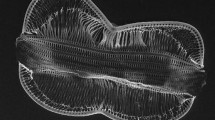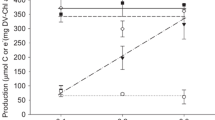Abstract
The effects of various metabolic inhibitors (dichlorophenyl dimethylurea, chloramphenicol, cycloheximide, carbonyl cyanide m-chlorophenyl hydrazone) on the accumulation of radiolabeled substrates (amino acids, glucose, bicarbonate, phosphate) by size-fractionated marine microbial plankton from the Sargasso Sea and the eastern Canadian arctic were studied in time-course fashion during experimental incubations either exposed to or shielded from ambient solar radiation. Picoplankton accounted for ≥65% of the organic substrates and phosphate accumulated by the assemblages. The rate of organic substrate accumulation was stimulated by solar radiation in some cases but inhibited in other cases. Presumably, stimulation and inhibition co-occur and the measured response is the net result arising from these counteracting tendencies. Approximately 40% of H14 CO3 − accumulation in the Sargasso Sea was associated with the picoplankton. The insensitivity of picoplankton14C-labeling to cycloheximide suggested active prokaryotic photosynthesis rather than heterotrophic assimilation of14C-labeled algal photosynthates as the route of labeling. The usefulness of some inhibitors was restricted in this study because of inconsistent correlations between the intended primary metabolic effect and the measured ecological response within the duration of the experiment.
Similar content being viewed by others
References
Azam F, Holm-Hansen O (1973) Use of tritiated substrates in the study of heterotrophy in seawater. Mar Biol 23:191–196
Bailey CA, Neihof RA, Tabor PS (1983) Inhibitory effect of solar radiation on amino acid uptake in Chesapeake Bay bacteria. Appl Environ Microbial 46:44–49
Berman T (1975) Size fractionation of natural aquatic populations associated with autotrophic and heterotrophic carbon uptake. Mar Biol 33:215–220
Berman T (1980) Multiple isotopic tracer methods in the study of growth, dynamics, and metabolic processes in marine ecosystems. In: Falkowski PG (ed) Primary productivity in the sea. Plenum Press, New York, pp 213–230
Bonin DJ, Maestrini SY (1981) Importance of organic nutrients for phytoplankton growth in natural environments: implications for algal species succession. Can Bull Fish Aquat Sci 210:279–291
Burney CM, Davis PG, Johnson KM, Sieburth JMcN (1981) Dependence of dissolved carbohydrate concentrations upon small scale nanoplankton and bacterioplankton distributions in the western Sargasso Sea. Mar Biol 65:289–296
Caron DA, Davis PG, Madin LP, Sieburth JMcN (1982) Heterotrophic bacteria and bacterivorous protozoa in oceanic microaggregates. Science 218:795–797
Cole JJ, Likens GE, Strayer DL (1982) Photosynthetically produced dissolved organic carbon: an important carbon source for planktonic bacteria. Limnol Oceanogr 27:1080–1090
Derenbach JB, Williams PJLeB (1974) Autotrophic and bacterial production: fractionation of plankton populations by differential filtration of samples from the English Channel. Mar Biol 25:263–269
Douglas DJ (1984) Microautoradiography-based enumeration of photosynthetic picoplankton with estimates of carbon-specific growth rates. Mar Ecol Prog Ser 14:223–228
Droop MR (1974) Heterotrophy of carbon. In: Stewart WDP (ed) Algal physiology and biochemistry. University of California Press, Berkeley and Los Angeles, pp 530–559
Ellis BK, Stanford JA (1982) Comparative photoheterotrophy, chemoheterotrophy, and photolithotrophy in a euphotic reservoir and an oligotrophic lake. Limnol Oceanogr 27:440–454
Faust MA, Correll DL (1976) Comparison of bacterial and algal utilization of orthophosphate in an estuarine environment. Mar Biol 34:151–162
Fuhrman JA, McManus GB (1984) Do bacteria-sized marine eukaryotes consume significant bacterial production? Science 224:1257–1260
Good NE, Izawa S (1973) Inhibition of photosynthesis. In: Hochster RM, Kates M, Quastel JH (eds) Metabolic inhibitors, a comprehensive treatise. 4. Academic Press, London, pp 179–214
Gray MW, Doolittle WF (1982) Has the endosymbiont hypothesis been proven? Microbiol Rev 46:1–42
Griffiths RP, Caldwell BA, Cline JD, Broich WA, Morita RY (1982) Field observations of methane concentrations and oxidation rates in the Southeastern Bering Sea. Appl Envir Microbiol 44:435–446
Harrison WG, Azam F, Renger EH, Eppley RW (1977) Some experiments on phosphate assimilation by coastal marine plankton. Mar Biol 40:9–18
Healey FP (1980) Slope of the Monod equation as an indicator of advantage in nutrient competition. Microb Ecol 5:281–286
Holmes RW (1958) Size fractionation of photosynthesizing phytoplankton. U.S. Fish and Wildlife Service, special scientific report: fisheries, no. 270, pp 69–71
Holmes RW, Anderson GC (1963) Size fractionation of14C-labeled natural phytoplankton communities. In: Oppenheimer CH (ed) Marine microbiology. C.C. Thomas Publishers, Springfield, Ill., pp 241–250
Iturriaga R, Zsolnay A (1981) Differentiation between auto- and heterotrophic activity: problems in the use of size-fractionation and antibiotics. Bot Mar 24:399–404
Iverson RL, Bittaker HF, Myers VB (1976) Loss of radiocarbon in direct use of Aquasol for liquid scintillation counting of solutions containing14C-NaHCO3. Limnol Oceanogr 21:756–758
Jensen LM (1983) Phytoplankton release of extracellular organic carbon, molecular weight composition, and bacterial assimilation. Mar Ecol Prog Ser 11:39–48
Johnson PW, Sieburth JMcN (1979) Chroococcoid cyanobacteria in the sea: a ubiquitous and diverse phototrophic biomass. Limnol Oceanogr 24:928–935
Johnson PW, Sieburth JMcN (1982) In-situ morphology and occurrence of eucaryotic phototrophs of bacterial size in the picoplankton of estuarine and oceanic waters. J Phycol 18:318–327
Johnson PW, Davis PG, Sieburth JMcN (1983) Diel variation of TCO2 in the upper layer of oceanic waters reflects microbial composition, variation and possibly methane cycling. Mar Biol 77:1–10
Joint IR, Pomroy AJ (1983) Production of picoplankton and small nanoplankton in the Celtic Sea. Mar Biol 74:19–27
Krempin DW, McGrath SM, Soohoo JB, Sullivan CW (1981) Orthophosphate uptake by phytoplankton and bacterioplankton from the Los Angeles harbor and southern California coastal waters. Mar Biol 64:23–33
Kuenzler EJ, Stanley DW, Koenings JP (1979) Nutrient kinetics of phytoplankton in the Pamlico River, North Carolina. Water resources research institute, University of North Carolina, report no. 139
Larsson U, Hagström Å (1979) Phytoplankton exudate release as an energy source for the growth of pelagic bacteria. Mar Biol 52:199–206
Larsson U, Hagström Å (1982) Fractionated phytoplankton primary production, exudate release and bacterial production in a Baltic eutrophication gradient. Mar Biol 67:57–70
Legendre L, Demers S, Yentsch CM, Yentsch CS (1983) The14C method: patterns of dark CO2 fixation and DCMU correction to replace the dark bottle. Limnol Oceanogr 28:996–1003
Lewin RA (1981) The prochlorophytes. In Starr MP, Stolp H, Trüper HG, Balows A, Schlegel HG (eds) The prokaryotes. Springer-Verlag, Berlin, pp 257–266
Li WKW (1984) Microbial uptake of radiolabeled substrates: estimates of growth rates from time course measurements. Appl Environ Microbiol 47:184–192
Li WKW, Subba Rao DV, Harrison WG, Smith JC, Cullen JJ, Irwin B, Platt T (1983) Autotrophic picoplankton in the tropical ocean. Science 219:292–295
McKinley KR (1977) Light-mediated uptake of3H-glucose in a small hardwater lake. Ecology 58:1356–1365
McKinley KR, Wetzel RG (1979) Photolithotrophy, photoheterotrophy and chemoheterotrophy: patterns of resource utilization on an annual and a diurnal basis within a pelagic microbial community. Microb Ecol 5:1–15
Morita RY, Iturriaga R, Gallardo VA (1981) Thioploca: methylotroph and significance in the food chain. Kieler Meeresforsch Sonderh 5:384–389
Morris I, Glover HE (1981) Physiology of photosynthesis by marine coccoid, cyanobacteriasome ecological implications. Limnol Oceanogr 26:957–961
Nalewajko C, Lee K (1983) Light stimulation of phosphate uptake in marine phytoplankton. Mar Biol 74:9–15
Neilson AH, Lewin RA (1974) The uptake and utilization of organic carbon by algae: an essay in comparative biochemistry. Phycologia 13:227–264
Newell SY, Sherr BF, Sherr EB, Fallon RD (1983) Bacterial response to presence of eukaryotic inhibitors in water from a coastal marine environment. Mar Environ Res 10:147–157
Pickard GL (1963) Descriptive physical oceanography. Pergamon Press, Oxford
Platt T, Subba Rao DV, Irwin B (1983) Photosynthesis of picoplankton in the oligotrophic ocean. Nature 300:702–704
Raven JA (1980) Nutrient transport in microalgae. Adv Microb Physiol 21:47–226
Rippka R (1972) Photoheterotrophy and chemoheterotrophy among unicellular blue-green algae. Arch Mikrobiol 87:93–98
Sieburth JMcN (1979) Sea microbes. Oxford University Press, New York
Sieburth JMcN, Johnson PW, Eberhardt MA, Sieracki ME (1983) Methane-oxidizing bacteria from the mixing layer of the Sargasso Sea and their photosensitivity. Eos 64:1054
Sieburth JMcN, Smetacek V, Lenz J (1978) Pelagic ecosystem structure: heterotrophic compartments of the plankton and their relationship to plankton size fractions. Limnol Oceanogr 23:1256–1263
Silver MW, Alldredge AL (1981) Bathypelagic marine snow: deep-sea algal and detrital community. J Mar Res 39:501–530
Smith AJ (1982) Modes of cyanobacterial carbon metabolism. In: Carr NG, Whitton BA (eds) The biology of cyanobacteria. University of California Press, Berkeley and Los Angeles, pp 47–85
Smith AJ, Hoare DS (1977) Specialist phototrophs, lithotrophs, and methylotrophs: a unity among a diversity of procaryotes? Bacteriol Rev 41:419–448
Spencer MJ (1979) Light-dark discrepancy of heterotrophic bacterial substrate uptake. FEMS Microbiol Lett 5:343–347
Thomson BE, Van Dyke H, Worrest RC (1980) Impact of UV-B radiation (290–320 nm) upon estuarine bacteria. Oecologia 47:56–60
Van Es FB, Meyer-Reil LA (1982) Biomass and metabolic activity of heterotrophic marine bacteria. Adv Microb Ecol 6:111–170
Vincent WF (1980) The physiological ecology of aScenedesmus population in the hypolimnion of a hypertrophic pond. II. Heterotrophy. Br Phycol J 15:35–41
Vincent WF, Goldman CR (1980) Evidence for algal heterotrophy in Lake Tahoe, California-Nevada. Limnol Oceanogr 25:89–99
Waterbury JB, Watson SW, Guillard RRL, Brand LE (1979) Widespread occurrence of a unicellular, marine, planktonic, cyanobacterium. Nature 277:293–294
Waterbury JB, Watson SW, Valois F (1980) Preliminary assessment of the importance ofSynechococcus spp. as oceanic primary producers. In: Falkowski PG (ed) Primary productivity in the sea. Plenum Press, New York, pp 516–517
Whittenbury R, Kelly DP (1977) Autotrophy: a conceptual phoenix. Symp Soc Gen Microbiol 27:121–149
Wiessner W (1979) Photoassimilation of organic compounds. In: Gibbs M, Latzko E (eds) Photosynthesis II. Photosynthetic carbon metabolism and related processes. Springer-Verlag, Berlin, pp 181–189
Williams PJLeB, Yentsch CS (1976) An examination of photosynthetic production, excretion of photosynthetic products, and heterotrophic utilization of dissolved organic compounds with reference to results from a coastal subtropical sea. Mar Biol 35:31–40
Wolter K (1982) Bacterial incorporation of organic substances released by natural phytoplankton populations. Mar Ecol Prog Ser 7:287–295
Worrest RC (1982) Review of literature concerning the impact of UV-B radiation upon marine organisms. In: Calkins J (ed) The role of solar ultraviolet radiation in marine ecosystems. Plenum Press, New York, pp 429–457
Yetka JE, Wiebe WJ (1974) Ecological application of antibiotics as respiratory inhibitors of bacterial populations. Appl Microbiol 28:1033–1039
Author information
Authors and Affiliations
Rights and permissions
About this article
Cite this article
Li, W.K.W., Dickie, P.M. Metabolic inhibition of size-fractionated marine plankton radiolabeled with amino acids, glucose, bicarbonate, and phosphate in the light and dark. Microb Ecol 11, 11–24 (1985). https://doi.org/10.1007/BF02015105
Issue Date:
DOI: https://doi.org/10.1007/BF02015105




